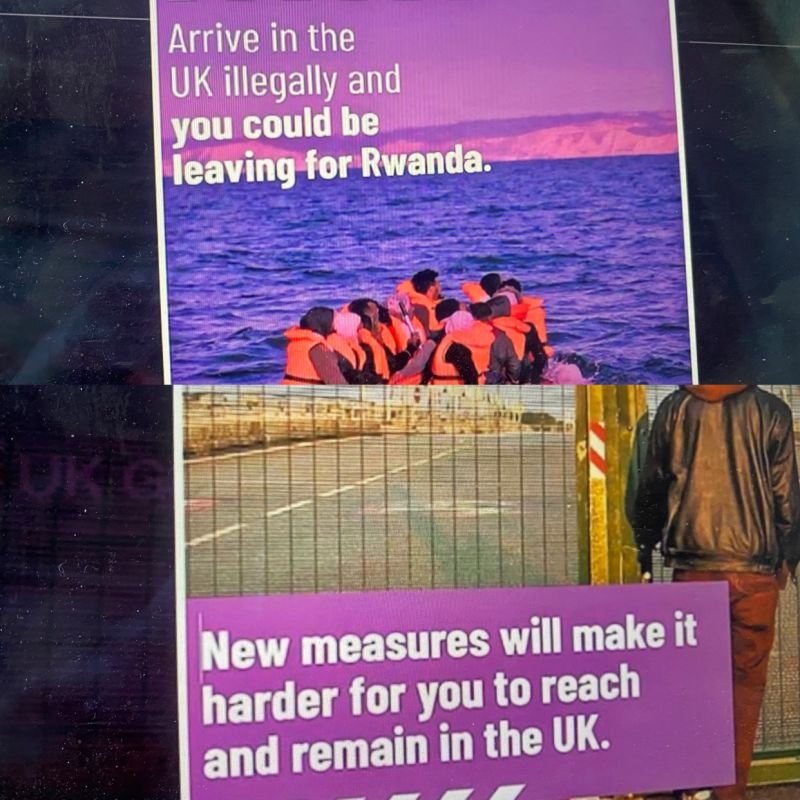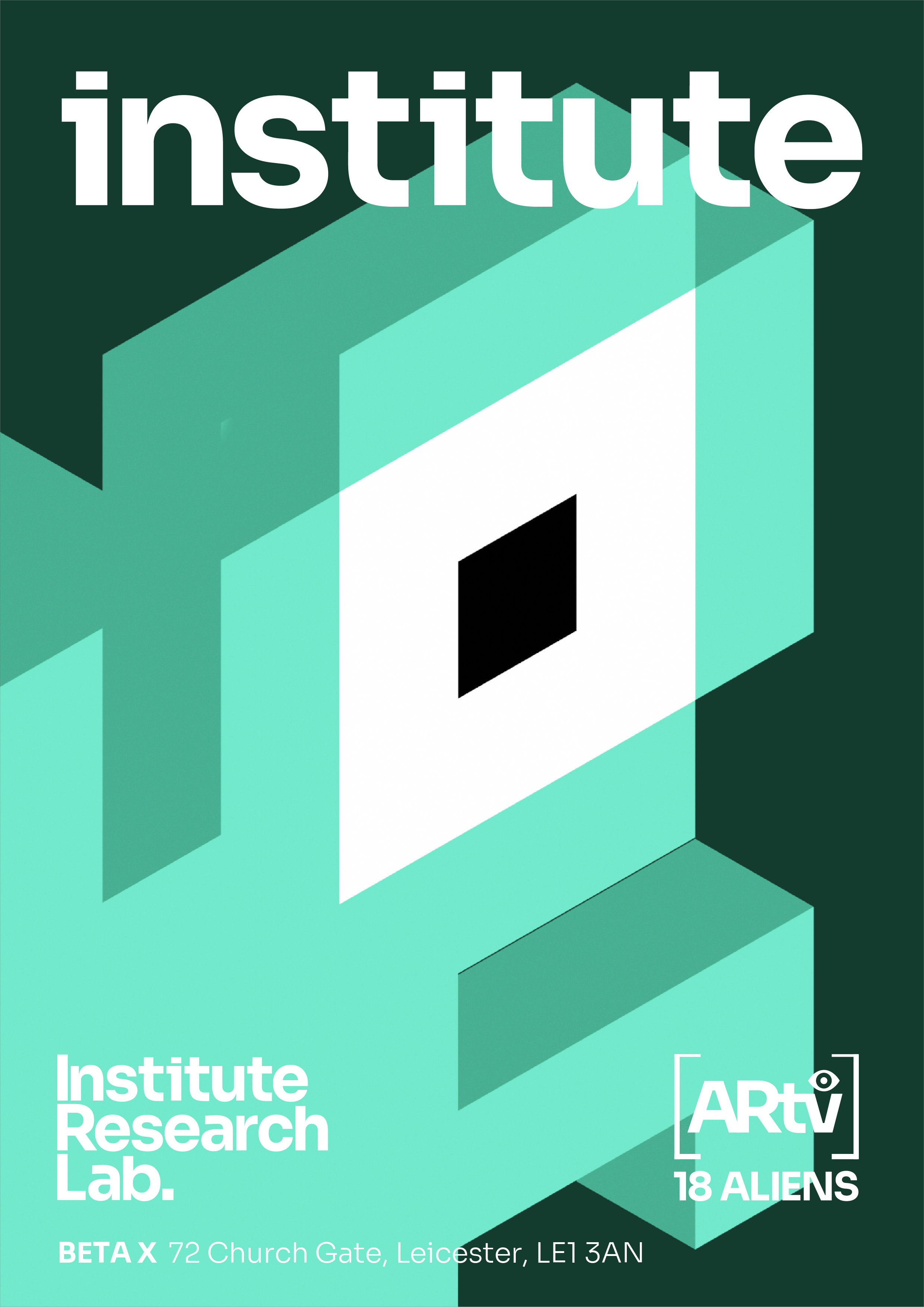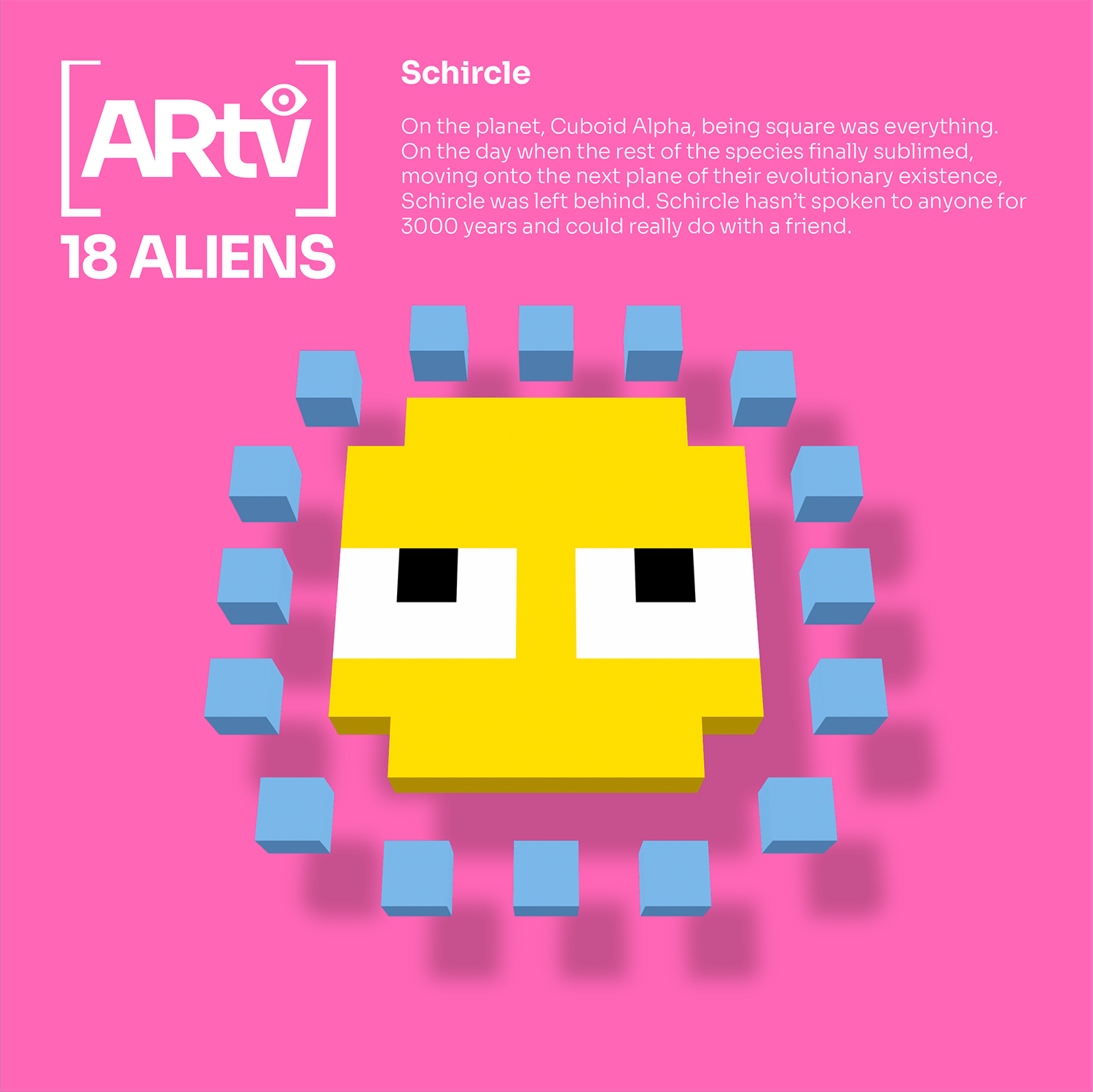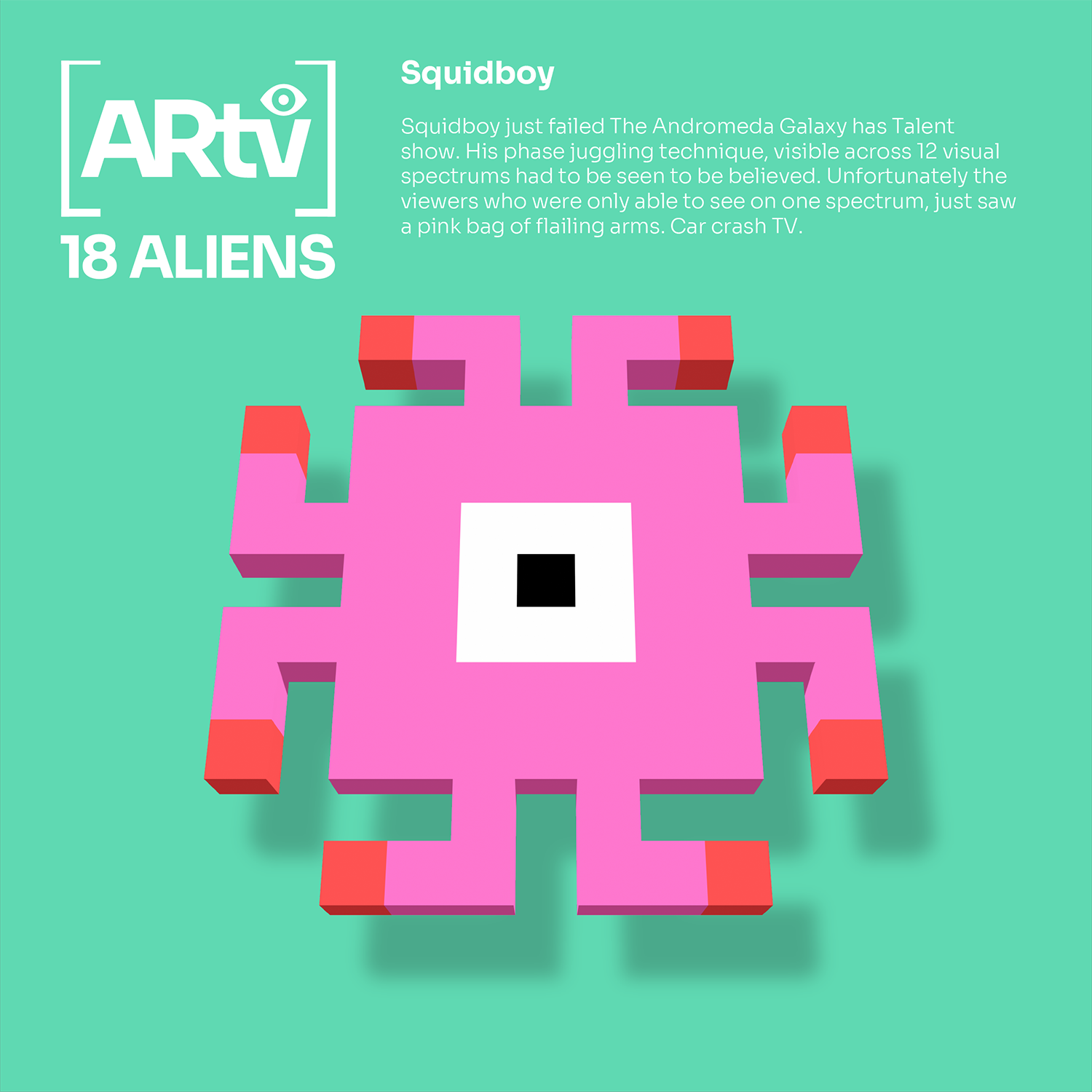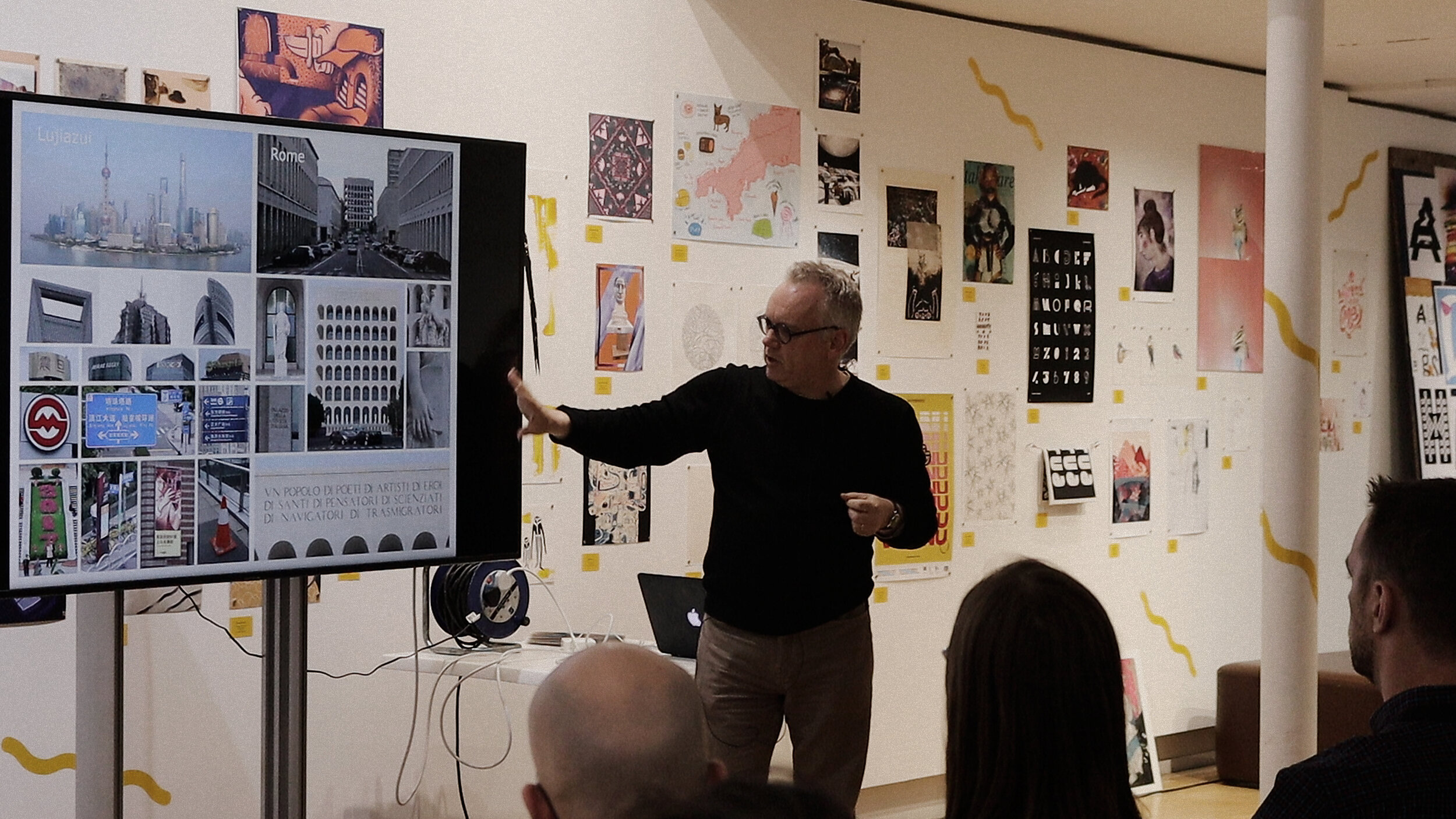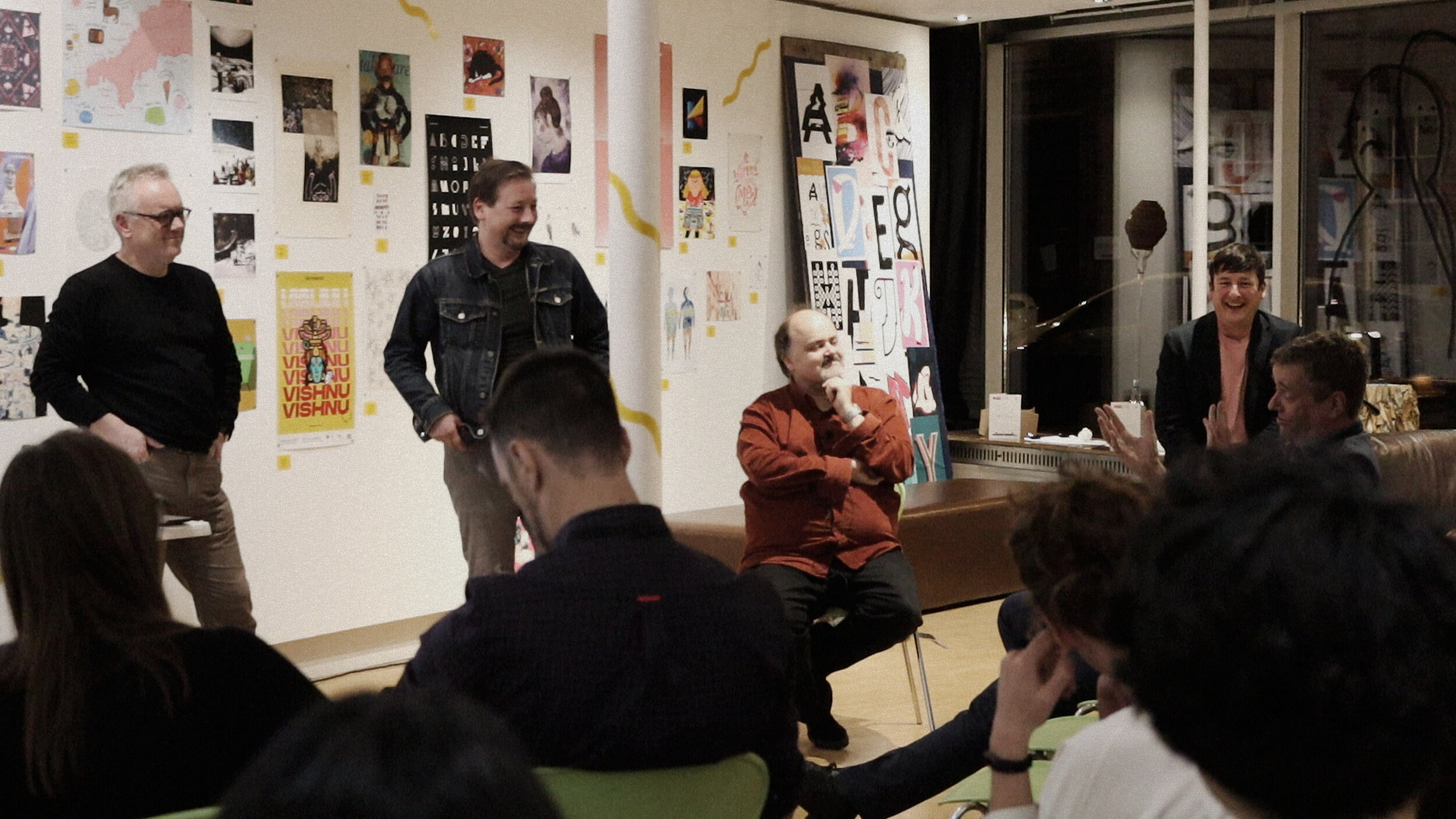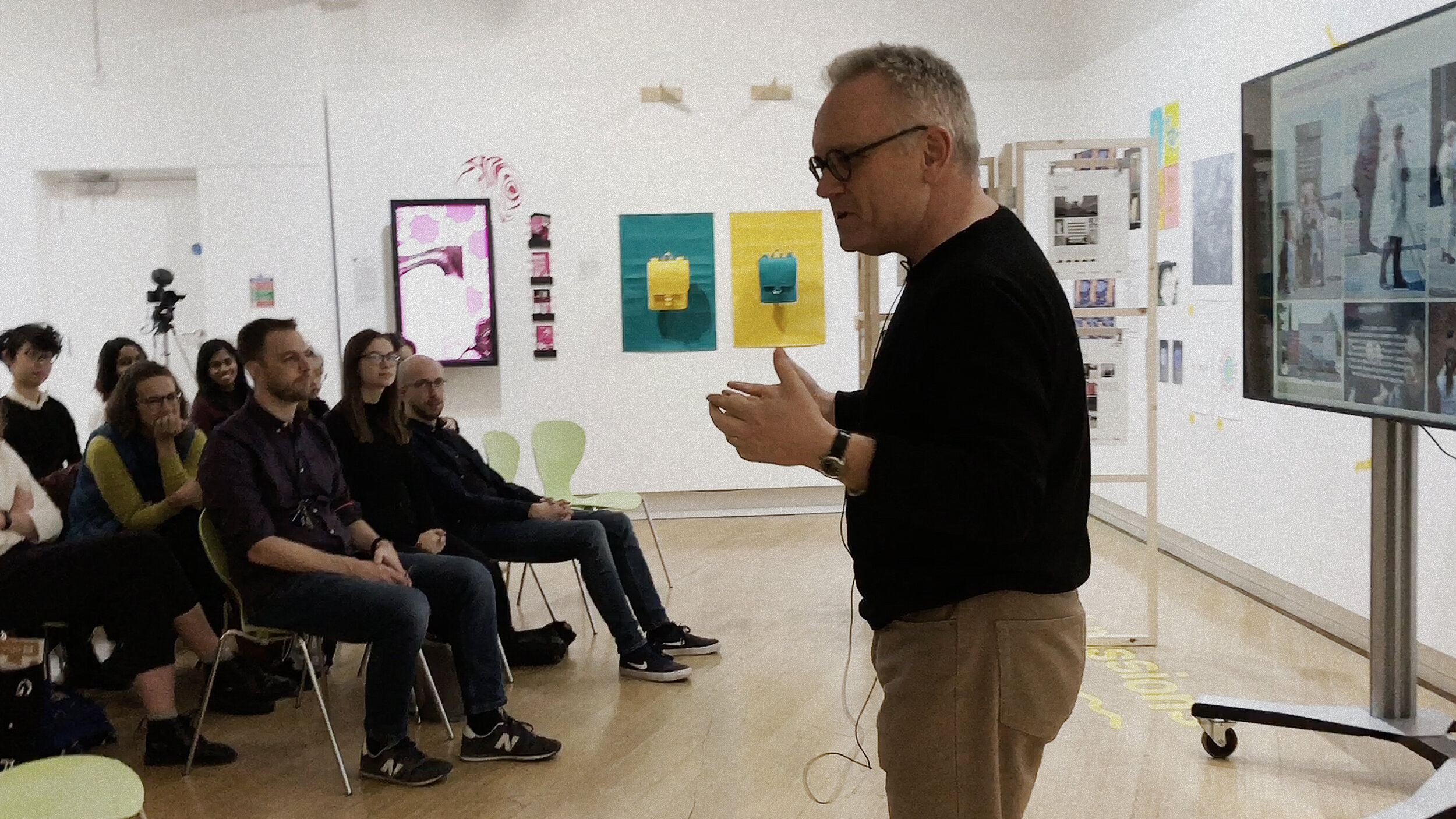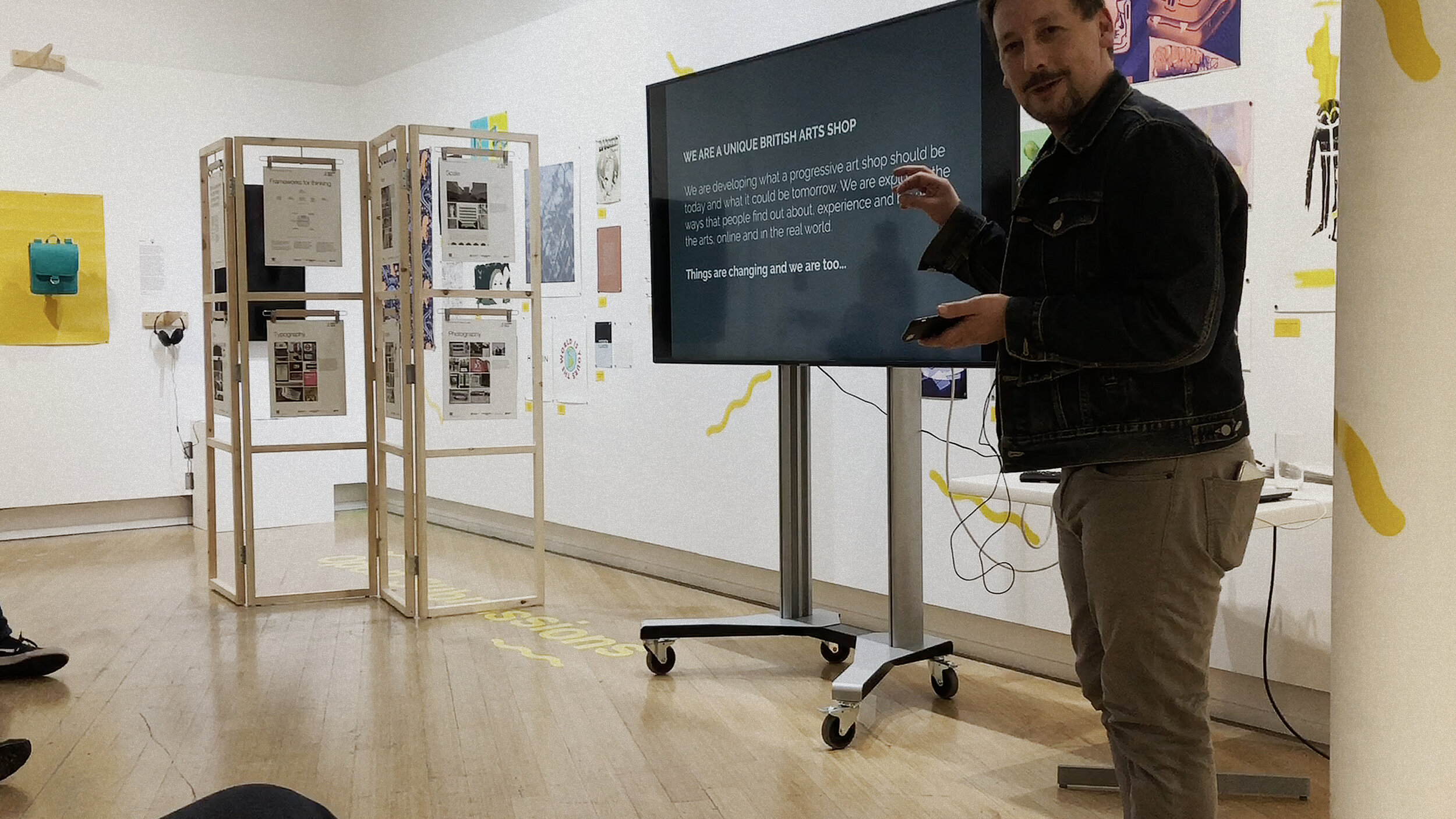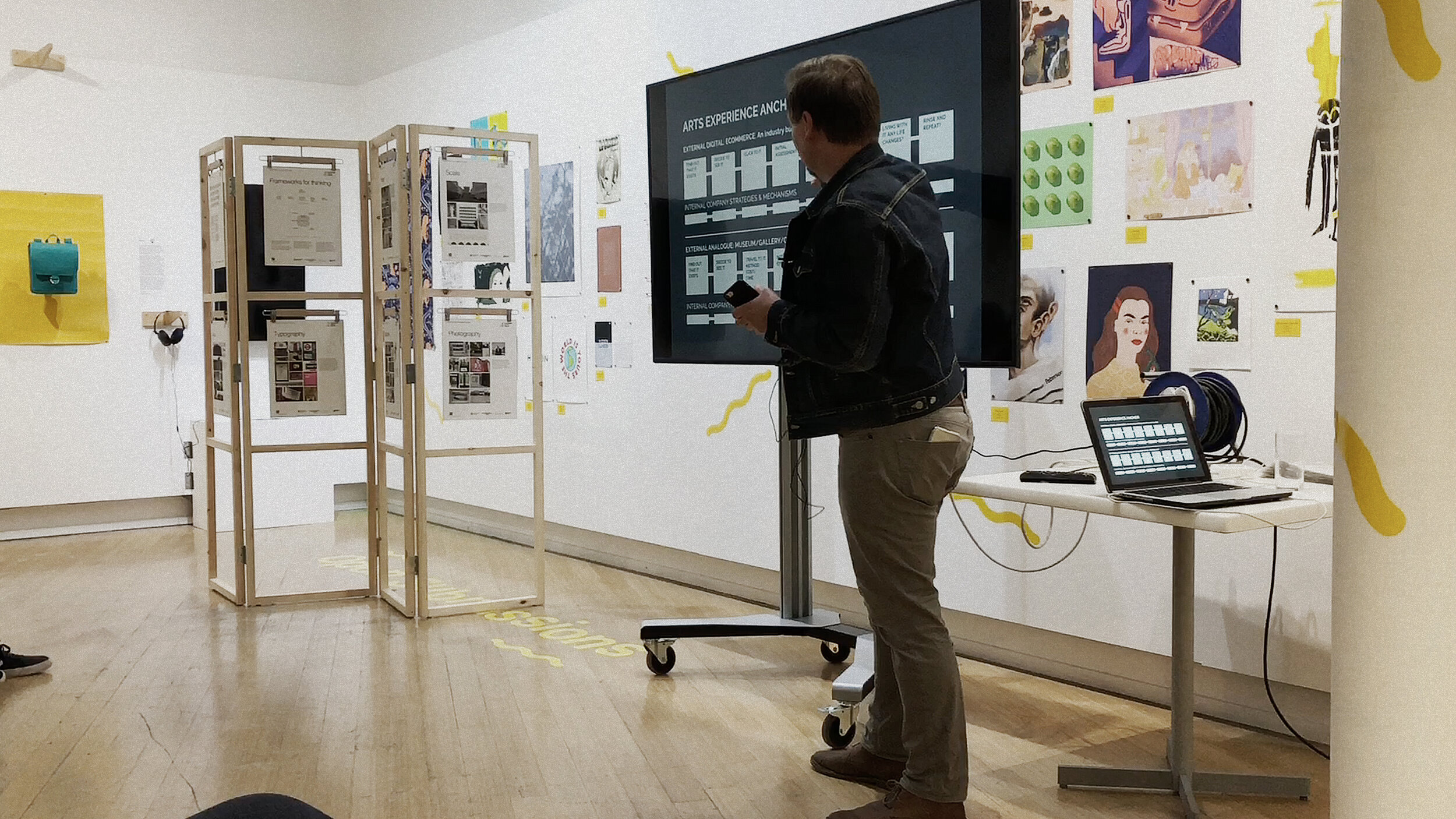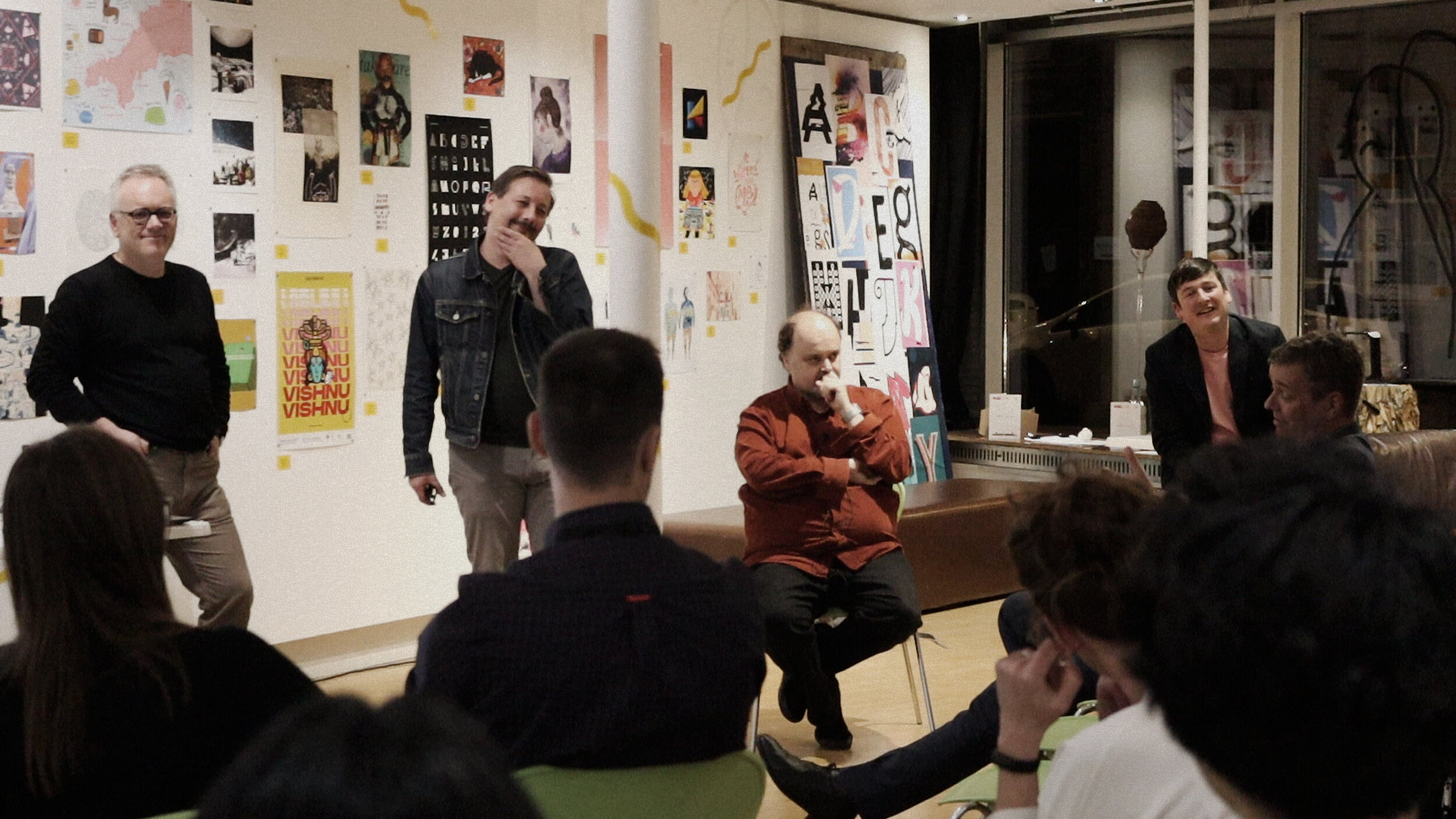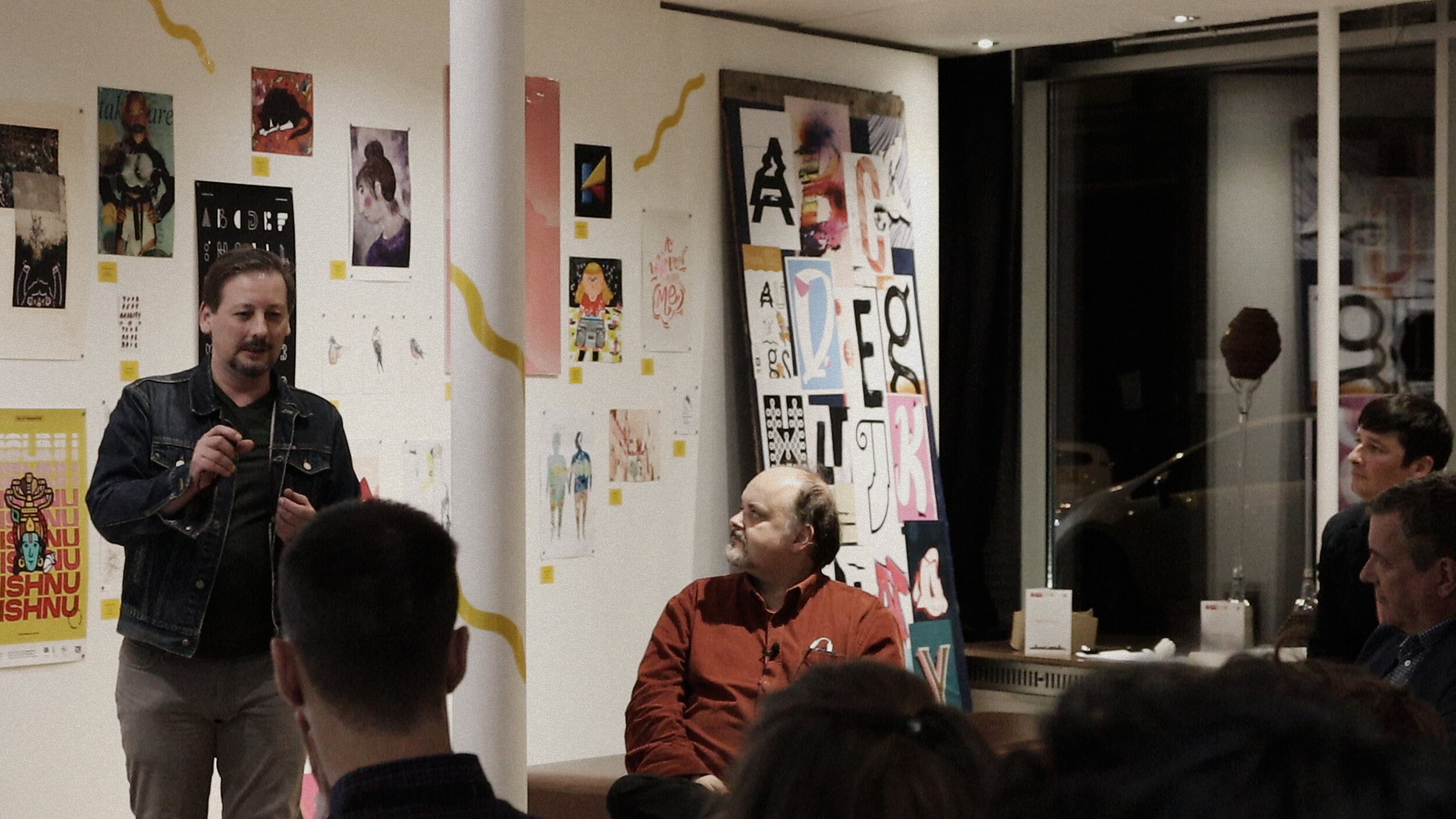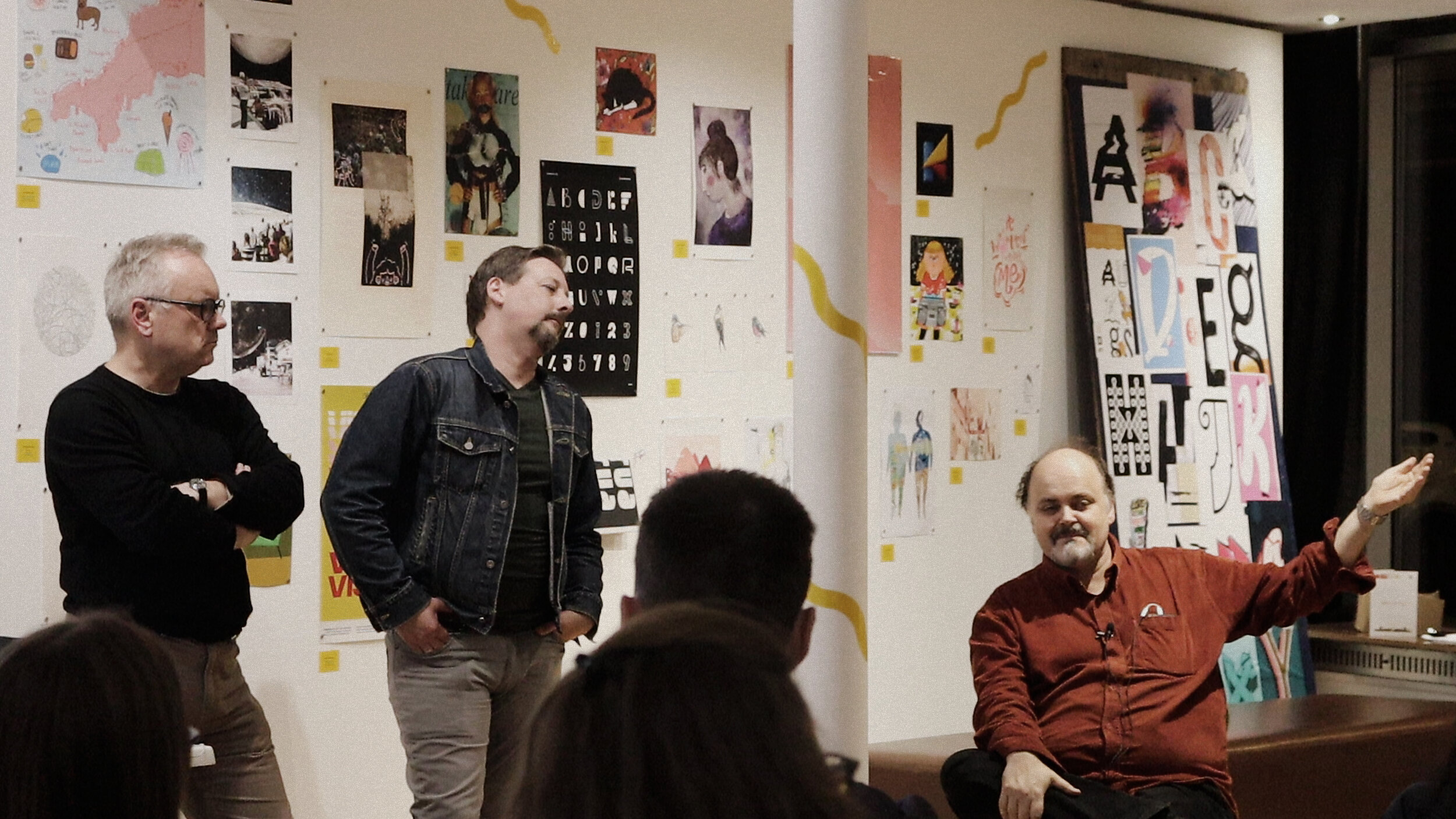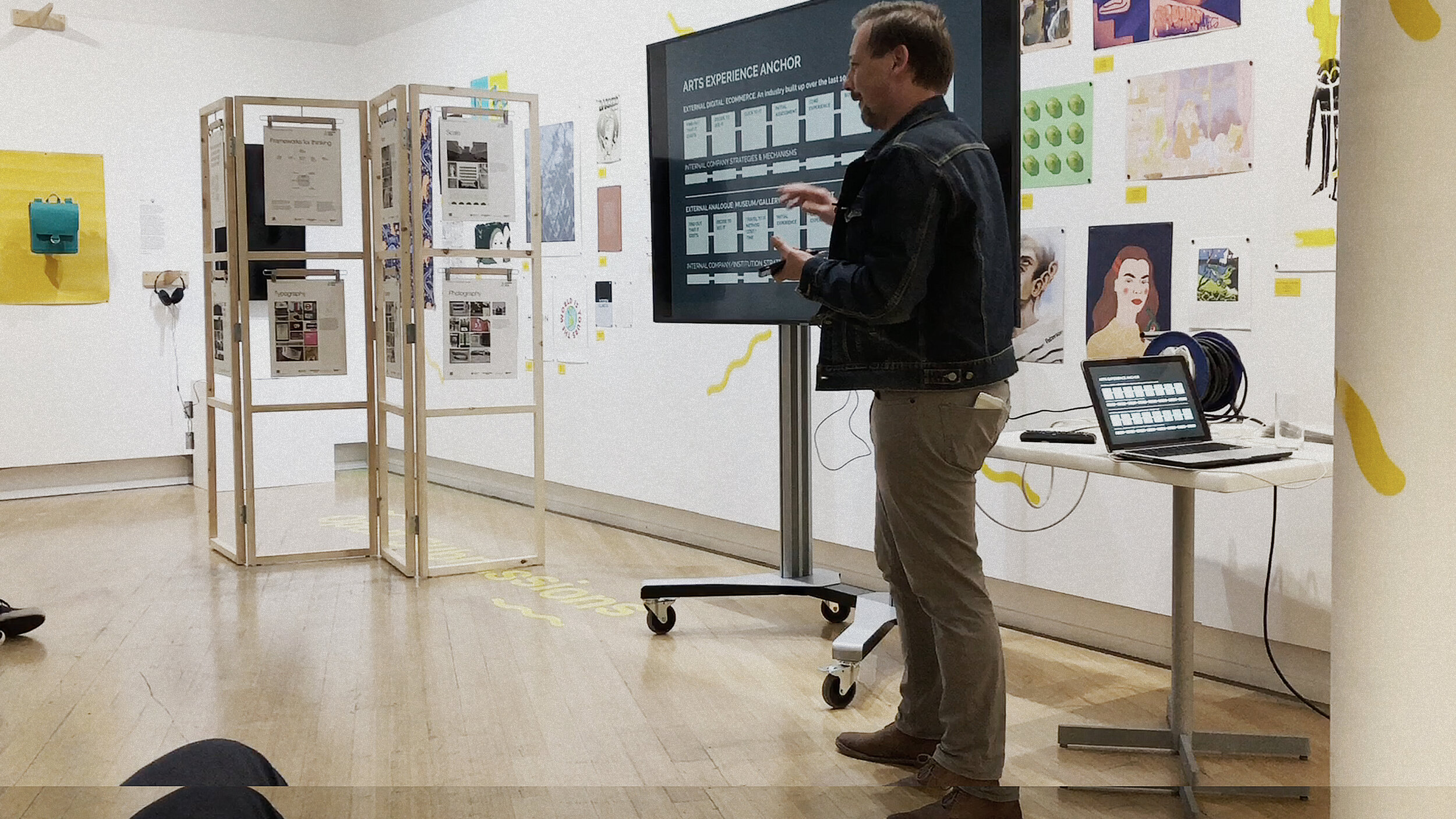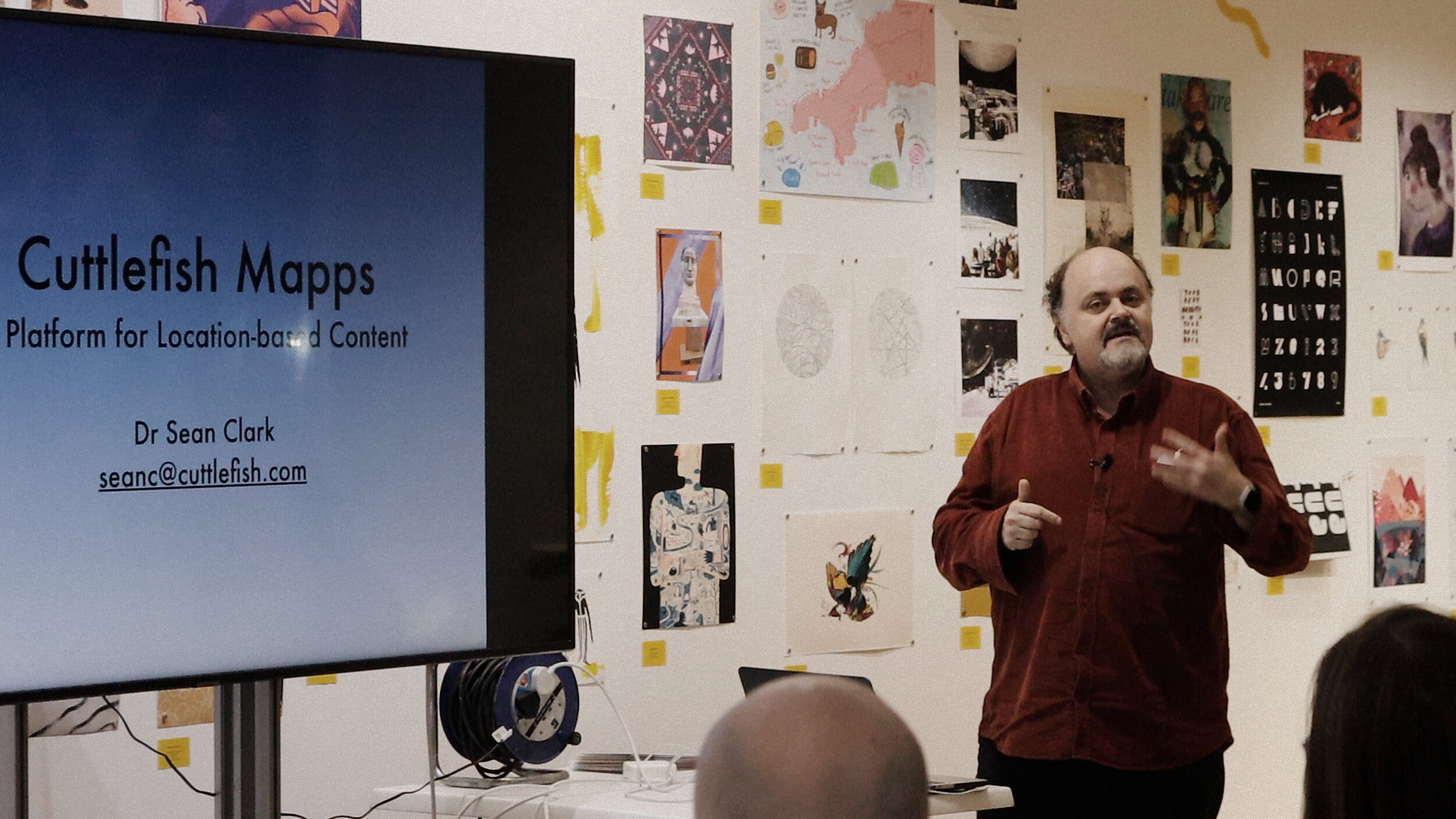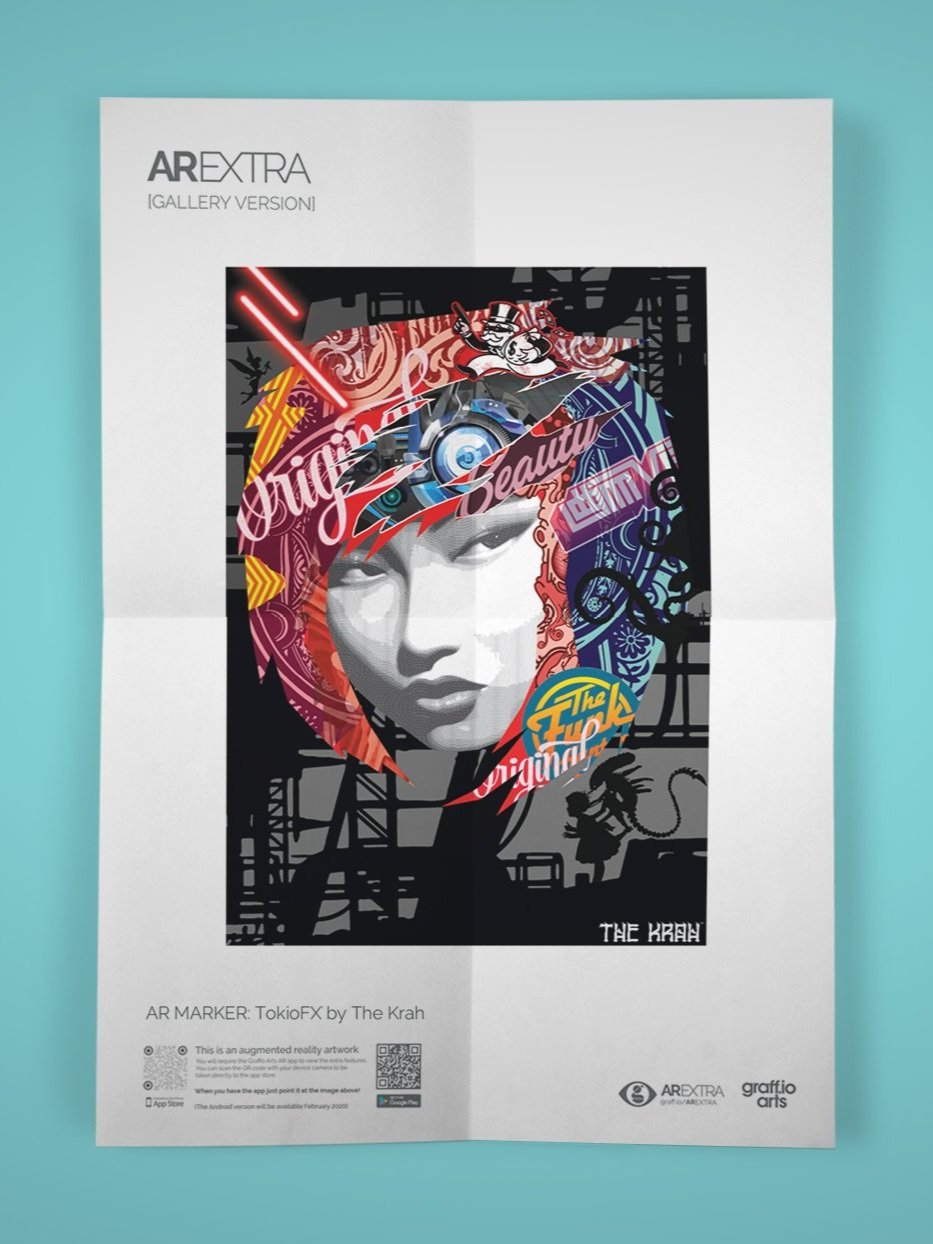CONTEXT
The Institute blog. A collection of information, essays and polemics relating to industry, culture and technology.
Business cannot exist in a vacuum. We examine the nature of ideas, communications and change within our contemporary cultural and technological landscape. We highlight potentially harmful actions and advocate for the freedom, meaning and agency required for human industry to thrive in a complicated and uncertain world.
Archive Fever
Five venues across the town kick off a new series of cultural events aimed at the local community.
Loughborough Lates is a new event hosted by five art and culture venues spread across the town centre and campus. Loughborough comes to life with visual art exhibitions, creative workshops and interactive events - all free to attend and participate in.
ARCHIVE FEVER
Archive Fever by Josie and Joshua Jones was shown at the Institute Research Lab at Loughborough Lates and will now be premiering on YouTube on Thursday 15th of December. In response to our 2022 Archive Fever exhibitions, this multi-screen installation shows interviews with six artists and contributors about the Leicestershire Museums Collection. Their conversations cover an array of topics, from nostalgia, conspiracy theories, preservation, and the personal responses they had to the objects within the archives. About Archive Fever The films shown in this installation are commissioned by Modern Painters, New Decorators as part of their exhibition programme, also titled Archive Fever.
The project centred around four solo exhibitions by visual artists; Joanne Masding, Jagjit Kaur, Daniel Cowlam and Katie Schwab. These projects began with a series of research trips to the Leicestershire Museums Collection, facilitated by Alison Clague, Senior Curator of the collection. The collection features a range of items relating to the county's history, including; rare butterflies, old farm tools, Victorian costumes, 1970s' Action Man', Neolithic stone axes and 19th-century engravings.
The artists used this research to produce new work inspired by the collection, and a selection of items from the collection were displayed alongside the newly created artwork. About Homespun Joshua and Josie Jones live and work together in Loughborough. They are also known as Homespun. Since graduating from the University, they've been developing as storytellers – mainly through photography and filmmaking, but more recently, this has opened out into all sorts of other creative practices. They spend much time with artists, charities and small businesses, working together on projects. They are part of the Modern Painters, New Decorators team and have documented their art programme for several years.
Make it stand out
Whatever it is, the way you tell your story online can make all the difference.
Make it stand out
Whatever it is, the way you tell your story online can make all the difference.
Participating venues: Charnwood Arts, the Institute Research Lab, LU Arts, Modern Painters, New Decorators and Sock Gallery.
THE FUTURE
A big thank you to @mpndprojects @sockgallery @lborouniarts @charnwood_arts and all those that turned up and took part. It always tricky to get this kind of thing organised and to get people together but it really is worth it. We met some great people and look forward to more Lates in the future!
#LoughboroughLates Contact mpndprojects@gmail.com for inquiries
Instagram @charnwood_arts @institute_lab @LUArts @mpndprojects @sockgallery
An Evening of Art, Design and Technology
Institute was one of the participating venues in the Loughborough Lates launch. The night included visual arts exhibitions, creative workshops and interactive events.
Institute was one of the participating venues in the Loughborough Lates launch. Loughborough Lates is a new event hosted by five art and culture venues spread across the town centre and campus. The night included visual arts exhibitions, creative workshops and interactive events.
Loughborough Lates is a new event hosted by five art and culture venues spread across our town centre and campus. From 5:30pm on Friday, 16 September, Loughborough will come to life with visual art exhibitions, creative workshops and interactive events - all free to attend and participate in. Maps are available at participating venues on the day. Charnwood Arts, Institute, LU Arts, Modern Painters, New Decorators and Sock Gallery, are the venues involved.
THE VENUES AND THEIR EVENTS
Charnwood Arts: 27 Rectory Place, LE11 1UW
Breathe, Create: Exhibition and Activity
The Charnwood Arts ‘Breathe, Create’ sessions are about engaging in mindful creativity. See our ‘Breathe, Create’ exhibition and try one of the activities with artist Khyati Koria Green, 6-7pm. We will also be showcasing the story of Songster, Loughborough's own War Horse, with author Alison Mott and artist Liz Waddell. Visitors can access us via our wheel-chair accessible front door.
Institute: Upper Rooms, 11 Baxter Gate, LE11 1TG
Ambient Visions: Martyn Blundell
A video installation that subverts the conditions in which we usually experience patterns, made up of shifting colour fields and ‘weaves'.
Crystal System: Leonie DuBarry-Gurr, Andy Harper and Todd Finnamore
An immersive and accessible sculptural installation with an interactive, contemplative soundscape.
LU Arts: Martin Hall, Epinal Way, LE11 3TS
The Domestic Academics: Finding the time to write and care
This project brings together twenty-three women academics with caring responsibilities, each responding to a call to create a quilt panel reflecting their experience working during the COVID-19 lockdowns. The gallery is located on Pearce Square, in Martin Hall. It is advised to park in the Cope Auditorium car park and walk across Epinal Way. It is directly opposite Cope Auditorium, which is next to Loughborough College.
Modern Painters, New Decorators: Carillon Court Shopping Centre, LE11 3XA
Hosiery Abstracts: Katie Schwab
Katie Schwab is a maker who works with installation, textiles, print and video to explore histories of craft, design and education. For this project, Katie immersed herself in local histories of machine knitting and attended a machine knitting course, learning techniques that have inspired new knitted artworks and a wall-based work. Visitors can enter our gallery via the Swan Street entrance of Carillon Court Shopping Centre.
Sock Gallery: Town Hall, Market Place, LE11 3EB
Our Charnwood and Beyond: Russel Taylor
Russell has an intense desire to capture the joy of the landscape. Working exclusively with acrylics, a completed painting is often a journey of chance! The gallery will be running a competition in the evening with a chance to win an exclusive Sock Gallery prize. Visitors enter the space through the front doors; everything is on one level.
AT INSTITUTE
We exhibited two exhibitions. In Studio 02, a screen based series of five video works by Martyn Blundell and an interactive installation by Leonie Dubarry-Gurr and Andy Harper in Studio 04.
Make it stand out
Whatever it is, the way you tell your story online can make all the difference.
Make it stand out
Whatever it is, the way you tell your story online can make all the difference.
Make it stand out
Whatever it is, the way you tell your story online can make all the difference.
CRYSTAL SYSTEM
There were curious looks on the faces of members of the lab as Leonie and Andy spent the week prior to the launch working on the technicalities of the installation in Studio 04.
Make it stand out
Whatever it is, the way you tell your story online can make all the difference.
Make it stand out
Whatever it is, the way you tell your story online can make all the difference.
Make it stand out
Whatever it is, the way you tell your story online can make all the difference.
Make it stand out
Whatever it is, the way you tell your story online can make all the difference.
Make it stand out
Whatever it is, the way you tell your story online can make all the difference.
An immersive and accessible sculptural installation, Crystal System offers new vantage points from which to come to terms with one's existence, in relationship to the world and others around us. Inspired by crystallised rock formations in the natural realm, Crystal System proposes an opportunity for contemplation via the meditative qualities of refracted and reflected light.In addition to the sculptural elements, the public can interact with a ruminative soundscape which supports contemplation.
Crystal SystemAcrylic, Wood, Light fixtures, Found objects.
Conceived by Leicester-based artists Leonie DuBarry-Gurr and Andy Harper in collaboration with Todd Finnamore.
www.andyharper.co.uk // @isandyharper // www.leoniedg.com // @beautiful__remainswww.monoworks.shop // @mono.works
AMBIENT VISIONS
Martyn Blundell is joining Institute as an associate. He kicks this off with a series of screen based works on display in Studio 02. If you ever wondered what would happen if you were to weave together the view a passenger might have during a series of global road trips, this might be it. They are beautiful, hypnotic and a little trippy! You can view Martyn’s video based art below.
These works belong to a series that has evolved, in part, from the idea of weaving space and time. Ambient Visions is a video installation that subverts the conditions in which we normally experience pattern. Shifting colour fields and ‘weaves' become a kind of metaphor for that feeling you get when travelling; an attempt to convey something of the porous state we fall in to when staring through the window of a moving vehicle. A dream-like travel metaphor.
THE FUTURE
A big thank you to @mpndprojects @sockgallery @lborouniarts @charnwood_arts and all those that turned up and took part. It always tricky to get this kind of thing organised and to get people together but it really is worth it. We met some great people and look forward to more Lates in the future!
#LoughboroughLates Contact mpndprojects@gmail.com for inquiries
Instagram @charnwood_arts @institute_lab @LUArts @mpndprojects @sockgallery
How to Market Misery, Suffering and Death
Welcome to propaganda marketed by Millennials. Is it as clumsy and deceitful as the ideas of the generation it seeks to represent?
On the left is a piece of work featuring an east African republic, with a history of genocide, put together by a designer working for the British Government. On the right is a poster for a fictional dystopian film set in South Africa.
Welcome to propaganda marketed by Millennials. Is it as clumsy and deceitful as the ideas of the generation it seeks to represent?
Article by Graffio Arts.
MARKETING MISERY
Institute is about the communication of ideas. What’s a useful idea? What’s the context? How can we communicate your idea to the people you want to talk to?
Sometimes we hit a hurdle and this hurdle is the biggest we’ve seen for a long, long time. We are human and these are ideas that we want to share with other humans. These ideas usually turn into well meaning outputs and we usually jump into the development of these with a shared ambition to say what you want to say, efficiently, for the good of all, or at least in a way where no one gets hurt.
But what if we are dealing with ideas that could potentially harm our fellow humans? That’s not good. So, put the kettle on, find a comfy chair and lets discuss how we market misery, suffering and death.
KILLING HOPE
This campaign is designed to illustrate how a sitting government is taking dynamic steps to deal with an apparent crisis. This is a government that uses catch phrases and simple, get-it-done concepts as key foundations for its communications. Focusing on the achievement of results (regardless of consequence) works for them and it will likely continue until the point where it stops working.
We’re going at the edges of this. Maybe that’s because it’s easier, maybe we’re cowards. Maybe we just think that this goes beyond politics. To borrow from another group that travelled across seas and oceans in the search of a better life, the human rights under threat here, we believe to be self evident.
Let’s start breaking this down. It’s all about hordes of troublesome, potential immigrants and the gangs that orchestrate the logistics of their travel.
The pitch is that the goal is to stop immigration and the suffering of those involved in these dangerous journeys. The plan will dissuade them from embarking on these journeys in the future and if that fails then there is a mechanisms in place to physically export them to Rwanda.
You may argue that, considering the financial cost associated with these plans, either way, we, the public don’t get to see them, and that is the key political goal here. One strand of this pitch is apparently about changing perceptions and the other is about the politics of a human and their requirements within a state. It’s a belt and braces approach. What’s not to like?
If that wasn’t problematic enough in terms of the Immigration plan, the marketing for this is largely hidden away in Facebook ads or in other discreet media outlets. These ads are paid for by this government and they are targeted to discreet audiences. This might give you an idea of the real audiences these ads are aimed at…
Make it stand out
Whatever it is, the way you tell your story online can make all the difference.
Make it stand out
Whatever it is, the way you tell your story online can make all the difference.
The premise is that this is part of the two pronged strategy- this is to dissuade potential immigrants and traffickers from embarking on a journey to the UK. Its about killing that dream. How would you target that specific audience? How would you deal with the varied languages? Are you using international ads? Do they even Facebook?
This isn’t what it says on the tin. This is for a specific British audience and its about affirmation of political ideas. The headline: New measures will make it harder for you to reach and remain in the UK is disingenuous to say the least. It should read, them. We are talking about them, those, those other than us.
Did they use specific science fiction tropes to indicate the other, the alien? We’ll look into this later but it does seem that this is a result of visual ignorance and lack of empathy rather than the development of a sinister visual language. The colour purple has been injected into the design of the ads above. Why do you think they did that? Is this about bleakness, alienation, isolation? Is this clever in an evil genius way or is it just clumsy?
Is doing something that’s bad, badly, good? Are we lucky that this could be something bad, done well and that would be really bad? How confusing. This equation doesn’t usually involve bad at the start and you have to wonder what was going through people’s minds when they embarked upon this campaign. We’ll come back to this point.
LET’S PRETEND THAT THIS IS HONEST COMMUNICATIONS
There is an argument that immigration isn’t really a problem, that making it a problem, is a political act. There is strong evidence to suggest that this initiative will not stop new journeys across the channel and that immigrants to Rwanda often stay for a limited time and then re-attempt the same journey or a new journey with a different destination, across Africa. It is difficult to maintain the idea that this initiative will stop gangs of human traffickers.
This campaign is used across social media. This is probably largely aimed at voters but we are hearing that this messaging is supposed to reach potential immigrants and to dissuade them from making the journey across the channel. If they are the ultimate audience and a proportion of them will die each year, this audience shrinks slightly but is replenished by new potential immigrants. If the messaging is supposed to end up with gang leaders, is the plan that they reassess the viability of their business in relation to this messaging?
Marketeers involved in the delivery of these campaigns are usually obsessed with audiences and data. Is death ignored here in the same way that we could say, the elderly receiving messages about the NHS will lose a proportion of their demographic as they die each year?
DOING BAD, BADLY
We believe that the underlying immigration campaign was designed by FCB INFERNO and that the Rwanda campaign was produced by Digital teams at no 10 or The Home Office in or collaboration across these teams. We asked key members but have not received a response. FCB INFERNO’s contribution was disclosed under a freedom of information act and the specifics of their involvement was addressed in an online article.
Looking through social media profiles, the Digital teams seem to be mostly in their mid to late 20s, career ambitious and proud to be producing ‘hard hitting’ work. Across government social media the campaigns produced are simple, clear and statement orientated. A few minutes of scrolling through Home Office feeds though, could make you feel that you’d been hit by an emotional truck. We accomplished this, here’s the numbers, we stopped this, we made this happen, more numbers, we made these people do this, rinse and repeat. All of these communications assume that the audience is okay with these decisions. The bullet points, the numbers, the evidence of accomplishments are brutally stark and the output is a bizarre visual soup of disjointed ideas, executed in mundane and inappropriate ways.
This is propaganda and it’s badly done. The visual language emerges out of the online ad space. There is very little understanding of graphic language or typography. The layouts are clumsy and the colour choices are just…silly.
Make it stand out
Whatever it is, the way you tell your story online can make all the difference.
Here’s an example from the New Plan for Immigration campaign. This is an animated sequence and shown above are four of the key frames. We are presented with a Union Jack background and a bold, positive logo. That tells us that something very patriotic is going on, its a bold endeavour and its progressive. Then we get a short story highlighting activities. People with no right to be in the UK were removed. The audience has to believe that this is a good thing. Is there context? It turns out that they are foreign, they are offenders and they are trying to abuse the British asylum system. The numbers are a counter and the 246 shown here shoots up to 527.
Why is this so simplistic? Why spend literal time on counting numbers? That border animates- it makes a journey around the square. It has a notch in the top left as if the frame somehow has 3 dimensions. The text and frame is in a bizarre lobster pink. Why do you think that is? Why would the designer spend time messing around with that silly frame? We are told that the information is about 527 criminals convicted of rape, manslaughter & attempted murder. Is that the colour of rape? Is that the colour of offence of any kind? What does the frame signify? Would it be inappropriate to suggest that someone involved in this wished that those attempted murders were actual murders? That would really hammer the point home. Is that statement a step too far? This is what happens to your rationality when you try to score political points within dehumanised systems of your own making.
In the same way that you could argue that these policy statements show little human empathy, the visual language is a step removed from the subject matter. Why are the people making policy and the designers involved in these communications one step removed from the subject and not displaying the competence usually required with these roles? Shouldn’t these roles attract the best of the best? Both of these parties are telling us that they are doing a good job.
Priti Patel has been working with a Digital team to produce a series of ‘hard hitting’ pieces about the ‘big issues’. This is a campaign where various people are brought in and filmed with Patel while she patronises them and turns what they say into sound bites. We know the way these people are treated could be better. We know it’s politics, we’re used to the ins and outs of that but it’s even more depressing for us when we see creatives collaborating in this way. It’s complicated and we maybe have a romantic view, but there was a time when the decision to go into the arts was a statement of intent. A willingness to see the world in new ways, to drive our culture forward, to enhance humanity, even if we’re stumbling along, doing our best in quite a humble way.
As the world of politics continues to change within a larger culture that continues to change, more and more young people are entering the arts. With that comes a larger spread of views and larger pools of roles available post University. Young creatives are increasingly seeing design, not as a process but as the way things look. The word aesthetic is now being used to purely mean, the visual. Design should be a process, not decoration. Contemporary creative courses and Industry should not be encouraging young creatives to be blandly professional and to do the stuff that looks like, the stuff. We shouldn’t know what the stuff should looks like until the end of the process. We used to know how to manage this danger and we valued the rewards.
Creatives must be ready to see things differently, to ask questions and they must take some cultural responsibility for the things that they produce. In the same way, those that are more experienced should be fostering an environment where questioning everything from the start is promoted as a healthy thing to do. They should be providing frameworks that have space for the development of appropriate outcomes- original outcomes, fit for humans, that contribute to society in meaningful ways.
The Digital teams across government should be asking themselves: ‘Did I take a career misstep? Should I really be in the cake decoration industry? Is that a vocation better suited to my abilities?’ When you are decorating a cake, the cakes been made. You don’t have to take any responsibility for the main job. With any luck, it’s delicious and if not, that’s not your fault. As long as it doesn’t contain anything that causes an allergic reaction and you don’t drop it, it’s all good. You only have to decorate it. There’s the top to deal with, maybe the sides if you’re feeling adventurous. Just grab that pink icing and start drawing silly things on the surface and then stand back and celebrate your genius. Voila! Your job is done.
This is the level that these people are operating at. It doesn’t matter what kind of cake it is, it doesn’t matter if its poisonous. It’s cake and cakes are amazing, therefore what they do is amazing. They messed around with some icing on the top. They drew a boat. The icing was pink and sugary and no one complained about how badly drawn the boat was. The boss loved it. They took a photo of it, put that on social media. Job done. Congratulations.
Maybe we’re making this more complicated than it is. Could it just be that bad ideas attract bad creatives?
KEEPING TALLY
Within a studio designers and artworkers are usually encouraged to take responsibility for the production of their work. They need to check if the work is the right dimensions, the logos are correct, messaging, colours, fonts are all good before they hit save and pass the work on to be published in one or more formats. They don’t usually have to assess human suffering. At what point is this discussed? Does the manager take responsibility or the artworker? Is there a debate between the manager and someone else at the Cabinet Office? How much of the messaging comes from an external source or is this creative team producing the messaging? With this change of policy does the creative team take note of the people that die each year before and after this campaign? If so and the tally of deaths is higher after a year of this new policy in place, do they resign? What kind of yardstick do they use to measure their contribution to our culture? If one of their audience dies they are no longer part of any culture.
CONTEXT NEUTRAL
In a situation like this, how do we measure success? What metrics do we use? Is this the continuation of the speech writer that wrote those memorable lines that helped get President X elected? This is just contemporary political communications right? In this situation, the digital communications emerging on social media are either incredibly naive or fuelled by some of the tricks we’ve already played out in dystopian future fiction.
You may be forgiven for thinking that the idea of social media savvy really just describes an ability to use the software, place text and images in bland but satisfactory configurations, and to remain conscience and context neutral at all times.
It’s at times like this, that we realise how lucky we are. We are managing to work with talented young creatives that we learn from every day, that often show more creativity, grace and common sense than we do.
ARE WE THE BAD GUYS?
“Bad men need nothing more to compass their ends, than that good men should look on and do nothing. He is not a good man who, without a protest, allows wrong to be committed in his name, and with the means which he helps to supply, because he will not trouble himself to use his mind on the subject."
-John Stuart Mill
For a very long time, most societies have incorporated groups of people capable of helping to deliver ideas that change society. These ideas have affected peoples states of mind; their sense of self, their perceptions of themselves in groups, their sense of urgency, their understanding of geographical location and boundaries, their concepts of ownership, power structures and their understandings of right and wrong.
Just because we can do a thing doesn’t mean that we should do a thing.
WITH THE MEANS WHICH HE HELPS TO SUPPLY
Imagine a gentleman with a German accent and a name that sounded a little like gerbils, approaching us with this brief: “I’d like you to help my brand conquer Europe. My blue eyed mates need a bit more room, y’know? Oh and we don’t like those guys…”
We know how this works. First of all, you need borrow from The Romans. They were pretty good at this style of branding. You’re going to need some compelling justifications for this. We could hijack some religion, maybe grab some pseudo-science? Your tone of voice needs to be a little shouty. Three colours will really show authority. You’re also going to need some sharp uniforms and we’ve got a cracking idea for a logo.
This stuff is easy in retrospect for those trained in this area and we’ve seen how well it works.
Tucker Carlson, a US media celebrity with a prime time spot on the Fox network promotes a fairly disturbing agenda and this isn’t inhibited by the fact that he’s never owned a TV. He has a writer. A second writer actually. The first one had to be dismissed when caught contributing to extreme right wing message boards.
Neo fascist organisations cite Carlson as the guy they learn from when they want to communicate across media outlets where tiki torches and white pointy hats are not quite de rigueur. There are certain tricks the writer uses that hint at certain ideas (if you know what you’re looking for) but seem innocuous enough to be palatable during prime time.
It is not impossible to imagine providing media advice and support that would galvanise opinion around extreme organisations that would eventually result in deaths. Should we do that? Of course not. But where is the line for those responsible for the communication of political ideas? If a political party is elected, it has a mandate. Does a creative employed by that party have a conscience free obligation to help them communicate? Are they in the clear if they are an office for communications that serves whichever party is currently in power?
REAL LIVES, REAL CONCERNS
Did that designer agree with the politics behind this social media campaign? Did they consider potential implications for those migrants? What were they thinking when they hit the save button? Do we, as creatives, take responsibility for communicating any ideas to the best of our ability or do we need to take a larger responsibility when these ideas can potentially lead to misery and death for thousands of people?
A quick web search prior to launch would have provided a host of questions and concerns around various humanitarian, economic, and logistical consequences of this plan. How were these fairly obvious concerns processed by the designer?
PUBLICLY AVAILABLE CRITICISM AVAILABLE PRIOR TO LAUNCH
The UK > Rwanda Migration Partnership is part of The New Plan for Immigration policy. Below is an open letter by refugee Action that criticises the plan and the consultation process surrounding the plan. This is The New Plan for Immigration policy statement.
JOINT OPEN LETTER IN RESPONSE TO NEW PLAN FOR IMMIGRATION CONSULTATION
On 23rd March 2021, the UK Government announced sweeping changes to how they will treat people seeking safety in the UK. Instead of fixing a system that’s been failing people for years, these changes take a wrecking ball to the very principle of asylum.
The UK Government has since invited public feedback on these plans. This would usually be a chance to challenge their plans, raise important details and hold the Government to account. But, as with the inquiry stage for the recent Sewell Report on institutional racism, this consultation is a sham.
The ‘New Plan for Immigration’ is a half-baked political manifesto. It lays out vague, unworkable, cruel and potentially unlawful plans justified by misleading or simply incorrect evidence, wrapped up in racist and divisive language.
The consultation is poorly designed, confusing and inaccessible. The documents are only available in English and Welsh. The questions are clearly designed to lead people into endorsing the Government’s plan.
The Government left people fewer than six working weeks to give their thoughts on the largest changes to the asylum system in two decades.
Normally consultations like this last at least 12 weeks. These six weeks also include Easter holidays, a May bank holiday, Ramadan and an election period during which those involved in local, mayoral and devolved nation elections are restricted in what they can say publicly.Most incredibly, this consultation does not prioritise the views and experiences of refugees and people seeking asylum. Not one question in the official consultation document asks people about their personal experiences of fleeing persecution or seeking safety in the UK. And the inaccessible process will make it more difficult for many of the most important voices of all to be heard.
This is not a process designed by a Government that genuinely wants to listen or has any interest in being challenged or changing its approach. We can only conclude this is a thinly veiled public relations exercise with a pre-determined outcome that we’ve been reading about on the front pages of newspapers for months.
It seems the Government has already forgotten the shameful legacy of Windrush. Just weeks ago, the Home Office signed a legal agreement requiring the department to properly consider the impacts of its policies on the groups of people they affect. It is our view that the Home Office has already failed to meet this commitment.
This Government already punishes refugees at every turn. Instead of fixing this injustice, they are doubling down on it. They are planning to leave traumatised people stuck in refugee camps on UK soil or in dangerous situations abroad. Their proposals are cruel, unjust and deadly.
“We believe in a caring and connected society, where everyone is included, and we can all thrive. These plans are a direct threat to that society. We will oppose them at every possible stage, and keep building the future we believe in.”
This letter is signed by the following parties:
#Together100
Abigail Housing
African Rainbow Family
All Out
Anti-Slavery International
ASIRT (Birmingham)
ASSIST Sheffield
Asylum Link Merseyside
Asylum Matters
Asylum Support Appeals Project
Asylum Welcome (Oxford)
Association of Visitors to Immigration Detainees (AVID)
Bail For Immigration Detainees
Baobab Women’s Project CIC
BeHarrogate District of Sanctuary
Belfast Islamic Centre
Belfast Multi-Cultural Association
Ben & Jerry’s Europe
Blandford Cares (Dorset)
Boaz Trust
Bradford City of Sanctuary
Bradford Rape Crisis & Sexual Abuse Survivors Service
Bristol Refugee Rights
Cambridge Convoy Refugee Action Group
Cambridge Refugee Resettlement Campaign
Caritas Shrewsbury
CAST-COMMUNITIES AND SANCTUARY SEEKERS TOGETHER (Southend)
Central Asylum Yorkshire
Cheshire, Halton & Warrington Race & Equality Centre
Citizens Advice Rotherham
City of Sanctuary Sheffield
City of Sanctuary UK
Co-Conveners Brighton & Hove Stand Up To Racism
Committee on the Administration of Justice, Belfast
Community Action for Refugees and Asylum Seekers
Croeso Menai Community Sponsorship Group
Cornwall Refugee Resource Network
Coventry Refugee & Migrant Centre
Darlington Assistance for Refugees
Derby City of Sanctuary Network
Derby Refugee Forum
Derbyshire Refugee Solidarity
Detention Action
Detention Forum
Devon and Cornwall Refugee Support
Displaced People In Action
Doctors of the World
Doncaster Conversation Club
Durham Student Action for Refugees
ECPAT
End Deportations Belfast
English+, Norwich
Enthum Foundation (East Sussex)
Entraide (Mutual Aid)
Ethnic Minority Sports Organisation Northern Ireland
Europe Must Act
Falmouth & Penryn Welcome Refugees
Family Refugee Support Project (GM)
Faversham and Villages Refugee Solidarity Group
Finchley Reform Synagogue
Freedom From Torture
Friends of the Drop-in for asylum seekers and refugees (FODI), Sunderland
Galeforce Productions Universal CIC
GARAS (Gloucester)
Gatwick Detainees Welfare Group
Govan Community Project
Greater Manchester Immigration Aid Unit
Growing Together Levenshulme
Hastings Community of Sanctuary
HASVO Harrow
Health Energy Advice Team (Liverpool)
Helen Bamber Foundation/Asylum Aid
Heart4Refugees, Wirral
Herts for Refugees
Home4U Cardiff
Hope and Aid Direct (Essex)
Hope and Dignity Hearth (Sheffield)
Horn of Africa People’s Aid Northern Ireland (HAPANI)
Host Nottingham
House of Guramayle
House Of Rainbow CIC (London)
Hull Help for Refugees
Humans for Rights Network
Institute of Race Relations
Ipswich and Suffolk Council for Racial Equality
JCORE (Jewish Council for Racial Equality)
Jesuit Refugee Service UK
Joint Council for the Welfare of Immigrants (JCWI)
Justice First – Stockton
Kent Refugee Action Network
Khai Tzedek CIC (Stoke)
LASS Lesbian Asylum Support Sheffield
Learn for Life Enterprise
Leeds Asylum Seekers Support Network
Leicester City of Sanctuary
Lesbian Immigration Support Group
Lewisham Refugee and Migrant Network
LGBT+ Consortium
Liberal Democrats for Seekers of Sanctuary
Light Up Black and African Heritage Calderdale
Liverpool City of Sanctuary
Manchester Migrant Solidarity
Manchester Refugee Support Network
Manuel Bravo Project
Mary Seacole House
Mary Thompson Fund
Maryhill Integration Network, Glasgow
Maternity Action
Medical Justice
Mermaids
Merseyside Law Centre
Merseyside Refugee Support Network
Micro Rainbow
Mid Wales Refugee Action
Migrant Action
Migrant Advisory Service (Kingston)
Migrant Advocacy Service
Migrant Voice
Migrants at Work (Oxford)
NACCOM
New Beginnings Project, Blackburn YMCA
New Routes Integration (Norwich)
North of England Refugee Service
North West Migrants Forum
Northern Ireland Women’s Budget Group
Norwich City of Sanctuary
Notre Dame Refugee Centre
Nottingham & Notts Refugee Forum
Nottingham Arimathea Trust
One and All Aid
Ozanne Foundation
PAFRAS
Penrith and Eden Refugee Network
Plymouth Hope
Positive Action in Housing
Pro Refugee Alliance
Project 17 (London)
Quaker Asylum and Refugee Network
Rainbow Home
RAS Voice
Reading Refugee Support Group
Reclaim the Agenda
Refugee Action
Refugee Action in Somerset East
Refugee Action Kingston
Refugee Compassion (Ayelsbury)
Refugee Rights Europe
Refugee Roots, Nottingham
Refugee Support Group, South Somerset
Refugee Women Connect (Liverpool)
Refugees Welcome Committee (Ken and Chel)
Rene Cassin
ReportOUT
Restore, a project of Birmingham Churches Together
Right to Remain
Ripon City of Sanctuary
Rural Refugee Network
Safe in Scotland
Safe Passage
Safety4Sisters North West
Sahir House
Samphire
SHARE (Supporting and Helping Asylum seekers and Refugees) Knowsley
South Yorkshire Refugee Law & Justice
Sanctuary on Sea (Brighton and Hove City of Sanctuary)
Scottish Refugee Council
ShipShape Health and wellbeing
Shropshire Supports Refugees
Solace Leeds
South Yorkshire Migration and Asylum Action Group
South Yorkshire Refugee Law & Justice
Southwark Day Centre for Asylum Seekers
St Augustine’s Centre, Halifax
Stafford Welcomes Refugees
Stonewall Equality
Student Action for Refugees
Sussex Interpreting Services
Tees Valley of Sanctuary
The Bridge + (Norfolk)
The Oasis Centre, Gorton
The Refugee Buddy Project Hastings, Rother & Wealden
The Voice of Domestic Workers
The Welcoming Association, Edinburgh, Scotland
The Well Multi-Cultural Resource Centre Glasgow
Theatre Company of Sanctuary (Southampton)
Thousand 4 £1,000
Time to be Out (York)
TransgenderNI
Trinity Safe Space, Halton
Trinity Safe Spaces, Runcorn and Widnes
UK Lesbian and Gay Immigration Group (UKLGIG)
UK Welcomes Refugees
Upbeat Communities
Vauxhall Community Law Centre
Voices in Exile
Voices in Exile (Brighton and Sussex)
Waging Peace
Wakefield District City of Sanctuary
Wandsworth Welcomes Refugees
Welsh Refugee Council
West End Refugee Service
Westminster Justice and Peace Commission
Wiltshire For Refugees
Wirral Change
Women for Refugee Women
Women With Hope
Women’s Resource and Development Agency (Northern Ireland)
Yarl’s Wood Befrienders
Young Roots
How did the designer process this? “Their proposals are cruel, unjust and deadly.” Surely these organisations have more knowledge on the subject than the designer? They are clearly concerned. When the plan hit the news outlets and more concerns, from more sources, started to air, did any of the team resign?
This information was easily available to the designer. If they were handed the brief in the morning, they could search online for this information at lunch time. If they received the brief in the afternoon, then they could find this information that night. Could we imagine that the team received the brief and the turn over was so fast that they didn’t have time to consider the implications? Within The Cabinet Office Digital team is there any room to boycott a given brief?
NEUTRAL POLITICAL COMMUNICATIONS?
What is the role of social media for a sitting government? To question policy? Communicate policy? Discuss or inform on the impact of policy? Aren’t there more democratic, productive and open ways that we could use these platforms rather than streaming propaganda? If those involved in political policy and those communicating it can’t behave in a sensible way, maybe we should play them at their own game and take away their toys?
In 1988, Fritz Gahagan, a former marketing consultant for US big tobacco, provided insight into the fundamental paradox faced by the tobacco industry: “The problem is how do you sell death? How do you sell a poison that kills 350,000 people per year, 1000 people a day?”
Television advertising of tobacco products was banned in the UK in 1965 under the Television Act 1964, which was later reinforced by an EU directive in the 1980s. The Tobacco Advertising and Promotion Act 2002 banned the direct and indirect advertising or promotion of tobacco products. In May 2016, the Tobacco and Related Products Regulations 2016 introduced tighter restrictions in relation to certain vaping products and electronic cigarettes. Standardised packaging for these products has been required since this time.
Make it stand out
Whatever it is, the way you tell your story online can make all the difference.
Make it stand out
Whatever it is, the way you tell your story online can make all the difference.
Could we imagine a system where political messaging was allowed one statement, had to be fact checked and had to be set in Helvetica and this could only be presented in black and white? This is a what if? proposition. Here’s another what if? Imagine a world where we all cared more about the lives of those other than us. A world where creatives believed that they had a role in society to question our norms and values and to express this investigation through their creativity, for the benefit of our culture. This requires as much discipline as it requires creativity. It does require some brave decisions at some points and some risk at others but the rewards are worth it. The rewards can be life affirming. They get us closer to the truth and occasionally these interventions become part of our cultural history. They become a flag in the sand, a clarion call urging us to do better.
THE CALL TO ACTION BIT
This is the end of the article and it’s the time where we think about a suitable call to action. This is traditionally a message and a link to somewhere that’s related to the subject. But this time its a different kind of call to action and it’s just this: before you hit save, just stop and think. Are you doing the right thing?
Aliens, NFTs and the Art of Sharing
As the land grab for virtual assets continues, 18 ALIENS is a light hearted experiment in physical and virtual sharing.
18 ALIENS & ARtv
18 ALIENS was a light hearted experiment in physical and virtual sharing. We gave away 18 sets of aliens on a first come, first served basis at Beta X in Leicester in March 2022.
Concept, design + production: Graffio Arts. Pixels: Jonathan Feuillet. 3D objects + animation: Jack Ellis. The brains behind the Beta X project: Seed Creativity. Funding: LCB. Beta X project manager: Ady Alexander.
Make it stand out
Whatever it is, the way you tell your story online can make all the difference.
Make it stand out
Whatever it is, the way you tell your story online can make all the difference.
Make it stand out
Whatever it is, the way you tell your story online can make all the difference.
Make it stand out
Whatever it is, the way you tell your story online can make all the difference.
Make it stand out
Whatever it is, the way you tell your story online can make all the difference.
WHAT IS ARtv?
ARtv is an augmented reality content delivery system. Show video or activate 3D objects whenever you point your mobile device at an ARtv symbol. Each symbol can be unique and each can deliver it’s own content. A symbol could be a picture, a graphic or a logo.
Symbols can be displayed anywhere that you can imagine - on a poster, a wall or even as a tattoo. If you’d like to find out how you could use ARtv for your project, then get in touch.
Make it stand out
Whatever it is, the way you tell your story online can make all the difference.
Make it stand out
Whatever it is, the way you tell your story online can make all the difference.
18 ALIENS AT BETA X
These aliens have no monetary value and are comprised of pixels. Each alien was presented as an augmented reality marker on a series of cards. These cards can be shared with friends, family or random strangers, as you see fit, sharing your ownership of the alien. Anyone that owns a card can download the Graffio AR app and point it at the card to summon their alien from a galaxy far away!
The concept of virtual ownership is becoming more and more a part of our daily lives. When viewing a movie, we used to purchase a physical product, like a DVD. Now, it is more common to pay a gatekeeper to allow us to stream content. In this interaction, we no longer own a physical object and our access to the content may only be for a limited time. Virtual properties in virtual worlds continue to develop in terms of status and real monetary value.
Crypto currencies are on the rise and NFT systems, designed to protect the intellectual property rights of creators are now a part of a frenzied land grab of virtual assets. Meta seeks to control our experience of the Metaverse. As these new frontiers continue to develop should we stand back and ask what we want from virtual worlds? How do we want to interact with each other? What do we value? Is it all about individual or corporate ownership? Remember when we used to share?
THE POSTERS
Make it stand out
Whatever it is, the way you tell your story online can make all the difference.
Make it stand out
Whatever it is, the way you tell your story online can make all the difference.
Make it stand out
Whatever it is, the way you tell your story online can make all the difference.
Make it stand out
Whatever it is, the way you tell your story online can make all the difference.
Make it stand out
Whatever it is, the way you tell your story online can make all the difference.
Make it stand out
Whatever it is, the way you tell your story online can make all the difference.
ALIEN PERSONALITIES
To establish the idea that each alien was an individual and worthy of collection, each alien had a backstory created. These were brief introductions with a name and a biography that was part hard sci-fi and part, a tongue-in-cheek riff on popular culture.
Make it stand out
Whatever it is, the way you tell your story online can make all the difference.
Make it stand out
Whatever it is, the way you tell your story online can make all the difference.
Make it stand out
Whatever it is, the way you tell your story online can make all the difference.
Make it stand out
Whatever it is, the way you tell your story online can make all the difference.
Make it stand out
Whatever it is, the way you tell your story online can make all the difference.
Make it stand out
Whatever it is, the way you tell your story online can make all the difference.
Make it stand out
Whatever it is, the way you tell your story online can make all the difference.
Make it stand out
Whatever it is, the way you tell your story online can make all the difference.
ALIEN BEHAVIOUR
The aliens had individual sounds, breathed and performed different actions when touched. Some would react if you got within a certain distance from them.
AUGMENTED REALITY AND YOU
A new world is opening up and if things play out in the ways that we are told that they will, it will have an enormous impact the ways that we do things. The increased use of augmented reality technology into our every day lives will likely be accelerated by brands like Apple that are investing huge sum of time and money into transforming our relationship with their current technology. We know this stuff is coming and its likely that we’re going to be using it as an addition or substitute for the technology that we current use. The day that augmented reality glasses become adopted as a mainstream device, is the day where mobile phones may start to look the quaint product of a previous generation.
The 3D aliens in this project use technology that is only currently, universally available on Apple devices although large parts of the project also worked on Android devices. We tend to create projects that have mixed functionality, so that they are as inclusive as possible.
If you’re interested in using some form of AR for a project, we can help you work through the kind of options available. Once you understand the basics and the limitations become clear, the fun starts as you consider all the things that you could do. There is incredible potential for new types of engagement, user journeys, brand associations and relationships to physical locations with augmented reality.
Want to do something incredible with AR? Tell us what you want to do!
Augmented Reality and a Sense of Place
How does graphic design in the urban environment affects your sense of place and how this might change through increased use of AR technology? Discuss!
As part of Design Season and hosted at LCB Depot in Leicester , we were asked to take part in a talk with Dr Robert Harland from Loughborough University and Dr Sean Clark from Interact Digital Arts. We were asked to consider how graphic design in the urban environment affects your sense of place and how this might change through increased use of Augmented Reality technology.
THE PROPOSITION
How does graphic design in the urban environment affect your sense of place? How is this changing through increased use of Augmented Reality technology? What new opportunities does this create for artists and designers? These questions and more will be discussed during this free session involving Dr Robert Harland from Loughborough University, Sean Clark from Interact Digital Arts and the directors of Graff.io Arts. There will also be the launch of Cuttlefish Mapps, a new locally-developed platform for distributing location-based content.
INTRODUCTION
This was the perfect chance for us to unravel our thoughts & idea's about the impact that Augmented Reality will have on communication, the art & design world and culture. Designers are starting to realise that with UX design that there are social/well being implications for their decisions so another discipline in the area of ethics should be brought to the table. With galleries like the V&A experiencing almost x10 the traffic online now, will AR help bring traffic from an online world to experience the physical? Will a city retain the rights to an augmented or virtual world or are we to expect a "land grab" on markers - who is in control? This was also a chance to unveil the Beta for our new Graff.io Arts Augmented Reality app & to demo it on a series of AR artworks.
AN EXCERPT OF THE TALK
We've looked into Augmented Reality and we've thought how do you do this? We've looked into apps that are avail & different technologies, The only way that we could find to really do it is to collab with @swipeandtap. A Leicester based tech company building a prototype Augmented Reality app with us.
We've got some pictures, we can show you some examples of augmented layers later.
We are GA. Small co based in Loughborough, there's only four of us. We do a lot of creative collabs. We say that we're an art shop. This is our opening statement, written about two months ago, And we're finding that it's already out of date.
We are exploring these new areas, which encompass the kind of things that are coming up within that shop experience. If you go to a museum & you're dealing with art in a museum. Or if you're dealing with a shop and you're buying online. There are all these different channels & projects coming up. We've met Sean Clark and formed Gallery Without Walls together. We have Robert ( quote ). There's a lot happening right now locally in Leicestershire. I've worked in London for many years & I'm so glad that I've come back here. I've worked in London for over 20 years and I'm so glad I moved back here - I'm seeing more doors opening here & more easily and more accessibly here.
One of our company agenda's is how can do innovative creative collabs & projects here and not go bankrupt! We're looking at ways of doing this and working out if there are ways possible to stop the "brain drain". Is there any way of doing collaborative projects here and not have to move to the capital. Get as much going on locally as possible.
We've got issues here: We say we are an art shop and we sell online. We also have a problem here where we talk about the real word. What is the real world ?
So we are finding ways that a company, that's traditionally a certain kind of art shop has to change and emerge and go forward. We're looking at all the steps around looking at art and experiencing art and all the things involved in that and how we might have to change with it. That's why we're interested in AR and XR tech, because there are all these different layers.
So this sums up where we're at right now, the genie is out of the bottle! This new tech means things will never be the same.
With Minecraft & Pokemon, the kids are all used to it's commercial. Within the arts, I've been into this since William Gibson in the 90's. It's been in the creative sci-fi and cyber punk mind set for a long time. Now the tech is here for us to finally get on with it !
If we are a company thats looking at selling art or dealing with art, and how does that relate to how a museum or a gallery would deal with it? And the core journeys to experiencing art.
So how do we find out about art?
If there's an exhibition on or a print is online for sale, you don't just wake up and a canvas it lands on your head! you have to find out that it exists. In the analogue world, you might see a physical advert on a bus or get a leaflet & other physical ways that you find out that something's available?
If we were selling stuff online, this might come from a facebook ad or a comment somewhere. If it's a gallery they're putting money into leaflets or it's word of mouth. ~There's all these things going on behind the scenes.
Then how do you decide to see it? If you're online, you might click it - or not. In the analogue space this would be able your initial experience of walking into a gallery space and experiencing the architecture etc. And your REAL experience of the art.
Then your real experience of the work. At this point, we could be looking at how Augmented reality could be used to add more layers to the art. So where you needed for example Paul McCartney to sing there, we could add another layer, we could add Paul McCartney! If it was a painting, we could add an overlay through your phone to give more information about that artist. These things are real tools that help industry and help the arts in different ways. This could be able art or the arts, but we might end up needing teams of people.
So where Robert is talking about physical cities, you've got town planners then engineers, then signage...
If you’d like to talk to us about any of these themes, including augmented reality, gives us a call or email us here.
Spatial 3D AR Development with Flexi-Modal TV
Experiments in 3D Augmented Reality.
Media technology: Graffio Arts. 3D model/animation: dspall
We have been working with Wigflex and Flexi-Modal TV on some augmented reality installations for the Wigflex City Festival. There are some incredible people involved (listed below) and we’ll let you know more as things progress.
A NEW WAY TO DO 3D IN AUGMENTED REALITY
The prototyping shown here takes advantage of the transparency features of augmented reality for iOS. You are viewing a video file of an animated 3D model rather than a 3D model sitting with the space. The model had previously been animated and rendered. This animated video is playing on the screen with a transparent background giving the appearance of a 3D object.
Notice the people walking behind the iPad screen, clearly visible through the transparency of the video. When you want to define how a 3D scene should appear within a space, this is a very practical way to curate the size and relationship to the viewer. For projects where interaction with the object, control of behaviours and size should be in the viewers hands as priority, then real 3D models are the way to go. See our 18 ALIENS project for an example of this.
FESTIVAL MUSIC
Actress, Adam Curtain, Adam Pits, Aicha Audiobahn, Ben UFO, Call Super, Congi, Coralie, Daisy Godfrey, Danielle, Darc City, Daseplate, desmond, Dudley Strangeways, Frost, Geoim, G3CKO, GiGi FM, Hizatron, Ido Plumes, JAY, Kay Fabe, Kassian, Kiara Scuro, Lisene, LNR, Lone & Esqueezy, Lukas Wigflex, LvndLxrd, Metaphi, Midland Niks presents the best of black bandcamp unreleased featuring: NVST, Parris, Peach fuzz, Peder Mannerfelt, Perspective, Pete Beardsworth, R.O.S.H, Snowy, Son of Philip, Sonja Moonear, Stem, Sybertekh, Tamer Sallam, Toe Syszlak, Unbound, Vandall and Yazmin Lacey.
FESTIVAL VIDEOS, ART AND PERFORMANCE
Alice Nimier, AVVA Studio, Baba Swettham, Diogo Olivero, Dspall, Gabriel Balagué, Julia de Martino, Ixian Optical, Manjit Sahota, Marija Marc, Mathilde Avogadro, Multimodal, NINA NANA, Oil Productions, Olly animator, Poets Against Racism, Prefix studios, Render Gal, Simone Salvatici, Will Plowman and the award winning artist Wolfgang Buttress.
An Exhibition about Technology and Worthless Art
More and more of our experience of the world is going to be mediated and that includes our experience of the arts.
We were asked by LCB if we had anything for an exhibition for their Lightroom Gallery. AREXTRA Street had just launched as posters aimed at the general public. Those posters were printed onto durable, self-adhesive vinyl, designed to be plastered across empty shop windows. How would we take that into a gallery situation? Would it be appropriate?
FROM THE STREET TO THE GALLERY
AREXTRA [Street version] was a vehicle that used augmented reality to increase exposure to the arts for the general public. This was a system where people walking through the streets of the city could experience the arts without having to visit a gallery. The audience had now changed and now expected to be confronted by the arts.
This was an opportunity to engage with some of the big questions that arise from augmenting art. In this situation a 2D representation of the work is recognised by the technology and used as the platform for augmentation. Traditionally a piece of work within a gallery is considered to be an object. That object is assumed to be loaded with cultural worth. A set of factors are used to agree a monetary worth.
Augmented reality doesn’t play by these rules.
A painting, traditionally using a canvas as the place where paint is applied is now read as an image. Our understanding, development and agreed rules of engagement with painting have changed over time. It could be argued that painting was used in illustrative terms, as imagery at certain points in history but through the 20th century we have developed a sophistication and engagement that recognises the application of paint to a surface as a the battleground where an artists fights through their practice.
The results of this are hung on a wall where this creative fight, the development of their practice is evidenced and forms part of a larger conversation.
AR ignores the physicality of the work and uses a snapshot as the basis for something else. The viewers experience is largely of this something else.
To draw attention to these issues we stripped the art of traditional cultural and monetary value- we called each piece a marker (the thing that AR technology recognises). We printed these onto sheets of paper of a unified size and pinned them to the wall. After the exhibition these sheets of paper had performed their job and were destroyed. Viewers could view the exhibition with our AR app and explore the augmented reality layers- the new focus for this work in this context.
We used Lewis Carroll’s excerpt from Alice in Wonderland to highlight the idea that the genie is out of the bottle. New media technology continues to change the way we interact with the world around us. More and more of our experience of the world is going to be mediated and that includes our experience of the arts.
How would we like to proceed?
THE MARKERS
Goldfinch by Lucy Stevens
Tropics by Alexandru Cinean
Untitled by Cibo
Foliage Tree by Mono
TokioFX by The Krah
Mountains by Paraskevi Papagianni
Untitled by Kris Trigg
Meteora by Cibo
Lights Out by Tyler Spangler
















